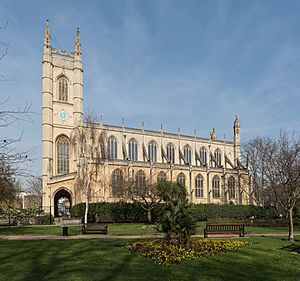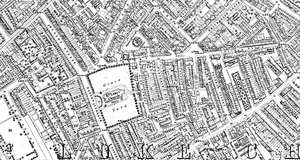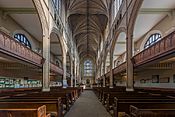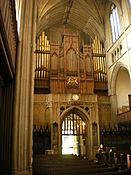St Luke's Church, Chelsea facts for kids
Quick facts for kids St Luke's Church, Chelsea |
|
|---|---|
 |
|
| OS grid reference | TQ 27193 78332 |
| Location | Sydney Street, Chelsea, London, SW3 6NH |
| Country | England |
| Denomination | Church of England |
| Churchmanship | Modern Catholic |
| History | |
| Status | Active |
| Architecture | |
| Functional status | Parish church |
| Heritage designation | Grade I listed |
| Architect(s) | James Savage |
| Completed | 1824 |
| Administration | |
| Parish | Chelsea St Luke and Christ Church |
| Deanery | Chelsea |
| Archdeaconry | Archdeaconry of Middlesex |
| Diocese | Diocese of London |
St Luke's Church, Chelsea is a beautiful Christian church located on Sydney Street in Chelsea, London. It's just a short walk from the famous King's Road. This church is an important part of the Diocese of London.
The church was designed by James Savage in 1819. It's special because it was one of the first churches in London built in the Gothic Revival style. This means it looked like older churches from the 1300s and 1400s.
St Luke's was also one of the first "Commissioners' churches." These churches were built with money from the British Parliament. Parliament gave £8,333 to help build St Luke's after the Church Building Act 1818. The church is now a Grade I listed building, which means it's a very important historic building. The gardens around St Luke's are also listed as historic.
Contents
History of St Luke's Church
In the early 1800s, Chelsea was growing from a small village into a busy part of London. People needed a new, bigger church closer to the center of the area. St Luke's was built to replace the older parish church, which is now called Chelsea Old Church.
The idea for the new church came from the rector of Chelsea, Gerald Wellesley. He was the brother of the famous Duke of Wellington. Wellesley was in charge of the church from 1805 to 1832. St Luke's Church was officially opened in 1824.
Building Design and Features
In 1819, James Savage's plans for the church were chosen from many ideas. He designed the church to look like Gothic churches from the 14th and 15th centuries. The church is made of Bath stone. It has a stone ceiling that is supported by flying buttresses on the outside.
One expert, Charles Locke Eastlake, said it was probably the only church of its time with a fully stone-vaulted roof. Another expert, Sir John Summerson, noticed that it looked similar to famous buildings like Bath Abbey and King's College Chapel, Cambridge.
Savage wanted the church tower to have an open spire, like a famous church designed by Wren. However, the Board of Works did not allow this. Summerson praised the design, saying it showed great skill and importance. He also said the inside of the church had a real sense of dignity.
St Luke's was a very big project. It cost £40,000 to build, which was a lot of money back then. It was designed to hold 2,500 people. It was one of the most expensive churches built with Parliament's money.
Church Organ and Interior Changes
The church has a large organ with many different sounds. It was first built by W. A. A. Nicholls and finished by Gray. In 1932, the organ was rebuilt by John Compton, using the original case and many of the old pipes.
When the church first opened, it was set up for preaching. It had a large pulpit, a small altar, and galleries above the side aisles. The way the inside looked was changed in the 1860s. However, the galleries over the nave aisles were kept.
St Luke's also got a large painting for its altar. This painting was called Deposition of Christ and was made by James Northcote. It was unusual for an Anglican church at that time to have such a large altarpiece.
Parish Connections
St Luke's originally shared its parish with Chelsea Old Church. Later, in 1839, another church called Christ Church was added. Christ Church is near Flood Street.
From 1860 to 1986, Christ Church was its own separate parish. But now, it is part of the same parish as St Luke's. This parish is called St Luke and Christ Church, Chelsea. Even though they are one parish, many church activities are still done separately for each church.
People Connected to St Luke's
Many interesting people have connections to St Luke's Church.
Famous Marriages and Baptisms
- The famous writer Charles Dickens married Catherine Hogarth at St Luke's on April 2, 1836. This was just two days after his first successful book, Pickwick Papers, came out.
- The architect Frederic Chancellor was baptized at St Luke's on May 18, 1825.
- The artist Robert Gill was married here on May 25, 1825. He later went to India to copy paintings in the Ajanta Caves.
- Another architect, William Willmer Pocock, also married at the church in 1840.
- The parents of Robert Baden-Powell, who started the Scouting movement, were married at St Luke's on March 10, 1846. His father, Baden Powell, was a well-known mathematician.
- Other people who married here include the writer William Hewson in 1830, and John Prideaux Lightfoot in 1835. Lightfoot later became a leader at the University of Oxford.
- The parents of the authors Charles Kingsley and Henry Kingsley were married here in 1854. Their father became the rector of St Luke's in 1836.
Notable Clergy and Musicians
Several important clergy members have served at St Luke's. These include Derek Watson and Ross Hook as Rectors, and Hugh Otter-Barry as a curate.
The church has also had many talented musicians as organists and choirmasters. Often, these roles were a step towards working in cathedrals.
- Two organists were composers who wrote famous hymn tunes: Sir John Goss wrote Praise, My Soul, The King of Heaven and the carol See, Amid the Winter Snow.
- John Ireland was another famous composer who worked here.
- Henry Forbes was a 19th-century composer and organist.
- More recently, Denis Vaughan and Jeremy Filsell have been Directors of Music.
Other Important People and Memorials
The Earls Cadogan have always supported the church because they owned the land around it. There is a special monument inside the church for Lt Colonel Henry Cadogan. He died in 1813 during the Battle of Vittoria. This monument was made by Sir Francis Chantrey.
Two famous actors from the past are buried in the churchyard. They are William Blanchard, known for funny roles, and Daniel Egerton. Both died in 1835. Margaret Bryan, an educator and writer, who died in 1836, is also buried there with her oldest daughter. James Savage, the architect who designed the church, is also buried in the churchyard.
St Luke's Church also has special chapels that remember soldiers. These are for the Punjab Frontier Force and the 3rd Gurkha Rifles from the British Indian Army. The screens in these chapels have regimental badges carved into glass by Josephine Harris.
Gallery
St Luke's in Film and Television
St Luke's Church has appeared in several movies and TV shows:
- It was seen in a scene from the 1996 movie 101 Dalmatians.
- The church was also featured in the fourth season of the TV show Made in Chelsea.
- In the movie Captain America: Civil War, the funeral of Peggy Carter takes place at St Luke's.
See also







